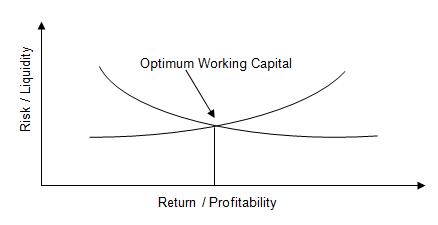Investment in working capital involves determination of the total quantum of current assets, the size of individual items of current assets and the operating cycle. These may be planned, adopting any of the following approaches, viz. industry norm approach, economic mode approach and strategic choice approach. Under the Industry norm approach the size and composition of current assets are determined according to the convention or norms adopted by die firms in the industry. For instance, 2 months production requirements of raw materials, 1 months production needs of work-in-process, 3 months sales of finished stock, 2 months credit to customers, etc. may be norms and you follow the norms. When this approach is adopted, automatically total volume arid component size of currents assets become proportional with level of activity. But this approach is not scientific. It is a rule of thumb. But we cannot say it is a wrong course. Under Continue reading
Working Capital Management
Optimum Level of Working Capital
A firm has to maintain an adequate level of working capital to run its operations smoothly and effectively. It should be adequate in the sense that it shall not be more than the requirements nor it shall be less than the requirements. Both the excessive as well as inadequate working capital positions are dangerous from the firm’s point view. We know that the current liabilities are met out of the current assets. So the level of current assets shall be sufficient enough to meet the current liabilities. Excessive working capital refers to the position where when the level of current assets is much higher to meet current liabilities. The excessive capital has opportunity cost for the firm, as this excessive capital remains idle in the firm, which earns no profit for the firm. If these funds shall be invested in some profitable project, it adds the profitability of the Company. Continue reading
Principles of Working Capital Management
Working capital management is concerned with the problem that arises in attempting to manage the current assets, the current liabilities and the inter-relationship that exist between them. The goal of working capital management is to manage a firm’s current assets and current liabilities in such a way that a satisfactory level of working capital is maintained. The financial manager must keep in mind the following principles of working capital management: Principle of Optimization:The level of working capital must be so kept that the rate of return on investment is optimized. In other words, the working capital should be maintained at an optimum level. This is the point at which the increase in cost due to decline in working capital is equal to the increase in the gain associated with it. According to the principle of optimization, the magnitude of working capital should be such that each rupee invested adds to Continue reading
Determinants of Working Capital
There are no set rules or formulate to determine the working capital requirements of a firm. The corporate management has to consider the various factors in making decisions regarding working capital balances. An appraisal of these would provide guidance to management in estimating prospective needs. These are called as determinants of working capital. The firm must estimate its working capital very accurately because excessive working capital results in unnecessary accumulation of inventory and wastage of capital whereas shortage of working capital affects the smooth flow of operating cycle and business fails to meet its commitment. In this section let us examine the various determinants of working capital. Nature of Business is one of the factors. Usually in trading businesses the working capital needs are higher as most of their investment is found concentrated in stock. On the other hand, manufacturing/processing business need a relatively lower compared to that of trading Continue reading
Inefficient Working Capital Management
Working capital management is an important component of management of corporate finance; since it directly influences firm’s profitability as well as liquidity in everyday activities. In any business organization, it is obvious that there must be sufficient working capital to run day to day operation. Therefore, to operate the business activities smoothly, working capital of firm’s must be sufficient. Then, the concern of working capital management is setting sufficient (optimal level) of working capital and managing short term assets and liabilities of firms within a specified period of time, usually one year. It is obvious that, the importance of efficient working capital management is unquestionable to all business activities. Because, business capability relies on its ability to effectively use (manage) receivables, inventories and payables. If there are excessive stock, debtors and cash and very few creditors, there will be an over investment in current asset. The inefficiency of managing working Continue reading
Estimation of Working Capital Requirements
In estimating working capital needs, different people adopt different approaches. Some experts suggest that the working capital should be greater than the minimum requirements of the firm. The management should feel safety. It would be able to meet its obligations even in adverse circumstances. However, the excessive capital may lead to waste and inefficiency. On the other hand, some experts suggest that the working capital should be lower than the requirement so that no idle funds shall be invested in the current assets and it ultimately leads to increase in profitability of the company. However, in such case the firm always have risk of technical insolvency as it may not meet its obligations as and when they falls due for payment. So the question is what the proper amount of working capital is?. It is not an absolute amount. It depends upon the needs and circumstances available in the firm. Continue reading

